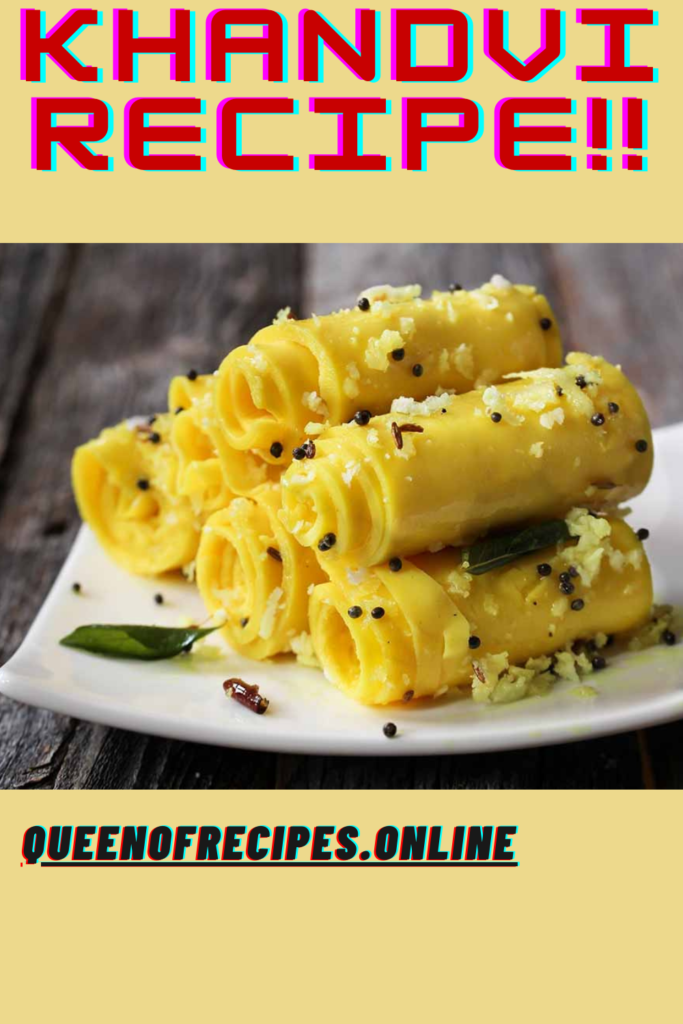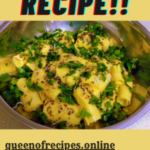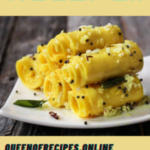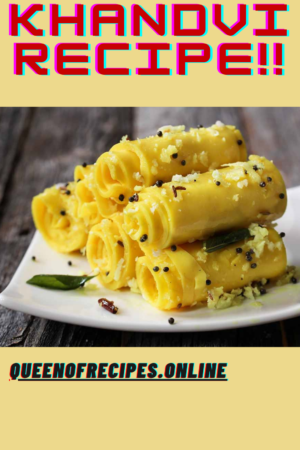Table of Contents
About Khandvi.
Khandvi, a delicacy hailing from the Indian state of Gujarat, is a savory and intricately rolled snack that showcases the artistry of Indian cuisine. Made from gram flour (besan), yogurt, and a blend of aromatic spices, it is a manifestation of culinary craftsmanship. The batter is cooked to a smooth, velvety consistency, then thinly spread and rolled into delicate spirals.
The result is a visually stunning treat with a uniquely soft yet chewy texture, often garnished with mustard seeds, grated coconut, and fresh coriander. Its charm lies not only in its exquisite appearance but also in its harmonious fusion of flavors—tangy, subtly spiced, and irresistibly addictive. This introduction invites you to explore the world of Khandvi, a timeless Indian snack that beautifully marries tradition and innovation.
Ingredients:
For the Khandvi Batter:
- 1 cup gram flour (besan)
- 1 cup yogurt (curd)
- 2 cups water
- 1/2 teaspoon turmeric powder
- 1/2 teaspoon ginger paste
- 1/2 teaspoon green chili paste
- Salt to taste
For the Tempering:
- 2 tablespoons oil
- 1 teaspoon mustard seeds
- 1 teaspoon sesame seeds
- A pinch of asafoetida (hing)
- 8-10 curry leaves
- Chopped fresh coriander leaves for garnishing
- Grated coconut for garnishing
Instructions:
- Prepare the Khandvi Batter:
- In a mixing bowl, combine gram flour, yogurt, water, turmeric powder, ginger paste, green chili paste, and salt. Mix well to form a smooth batter, ensuring no lumps remain.
- Cook the Batter:
- Pour the batter into a non-stick pan and cook over low heat, stirring continuously to avoid lumps. The batter will thicken as you cook it.
- Spread the Batter:
- Once the batter is cooked and thickened, quickly spread a thin layer onto the back of a greased plate or a smooth surface like a kitchen counter. Allow it to cool slightly.
- Roll the Khandvi:
- Once the spread batter begins to set but is still pliable, gently start rolling it from one end to create thin rolls. Repeat this process with the remaining batter.
- Prepare the Tempering:
- Heat oil in a small pan. Add mustard seeds, sesame seeds, and asafoetida. Once the seeds splutter, add curry leaves and sauté briefly.
- Pour the Tempering:
- Carefully pour the prepared tempering over the rolled Khandvi. It will infuse the rolls with a delightful aroma and flavor.
- Garnish and Serve:
- Garnish it with chopped fresh coriander leaves and grated coconut. Allow it to cool slightly before cutting it into bite-sized pieces.
- Serve:
- Serve it as a delectable snack, either as a standalone dish or paired with green chutney or tamarind chutney.
Tips:
- The key to making perfect Khandvi lies in spreading the batter thinly and evenly. Work quickly while spreading the batter on the plate to achieve the desired consistency.
- If the batter becomes too thick while cooking, you can add a little water and stir to adjust the consistency.
- Rolling the Khandvi requires a bit of practice. Don’t worry if the first few rolls aren’t perfect—they’ll still taste delicious!
- You can adjust the amount of green chili paste according to your spice preference.
With a bit of patience and practice, you can create the delicate and flavorful Khandvi that’s beloved in Indian cuisine.


Nutritional Value.
The nutritional value of Khandvi can vary based on the specific recipe and portion size. Here’s an approximate breakdown for a serving (about 4-5 pieces):
Nutritional Values (Per Serving):
- Calories: Approximately 150-180 kcal
- Carbohydrates: Around 15-20 grams
- Protein: About 5-7 grams
- Fat: Approximately 8-10 grams
- Saturated Fat: Around 1-2 grams
- Monounsaturated Fat: Approximately 5-7 grams
- Polyunsaturated Fat: About 1-2 grams
- Fiber: Around 2-3 grams
- Sugar: Approximately 2-3 grams (from natural sources)
- Sodium: Varies based on salt content
Please note that these values are approximate and can vary based on factors such as the thickness of the rolls, the amount of oil used for tempering, and any additional garnishes. Khandvi is a flavorful snack that provides a balance of carbohydrates, protein, and fats, making it a delightful addition to your culinary repertoire.
Health Benefits.
Khandvi offers a range of health benefits that make it a nutritious and enjoyable snack:
1. Low in Calories: It is relatively low in calories, making it a guilt-free option for snacking.
2. Good Source of Protein: Gram flour (besan), a key ingredient in Khandvi, is rich in protein, which is essential for muscle repair and growth.
3. Nutrient-Rich: It contains essential nutrients like B vitamins, iron, and dietary fiber, contributing to overall well-being and supporting bodily functions.
4. Digestive Health: The dietary fiber in Khandvi supports healthy digestion, aids in regular bowel movements, and promotes gut health.
5. Probiotics from Yogurt: The use of yogurt in the batter introduces probiotics, which are beneficial for gut health and can aid in digestion.
6. Heart-Friendly: It is generally prepared with minimal oil and is low in saturated fat, making it heart-friendly and supporting cardiovascular health.
7. Balanced Flavor: It incorporates a blend of spices like turmeric, ginger, and green chilies, providing both flavor and potential health benefits such as anti-inflammatory properties.
8. Gluten-Free Option: It is naturally gluten-free, making it suitable for individuals with gluten sensitivities or celiac disease.
9. Satiety: The combination of protein, fiber, and fats in Khandvi can help you feel full and satisfied, which can be helpful for weight management.
10. Controlled Portion Size: It is typically enjoyed in bite-sized pieces, promoting portion control and mindful eating.
11. Versatile: It can be customized with various spices and herbs according to personal preferences, offering a diverse flavor profile.
12. Nutritional Variety: The use of mustard seeds, sesame seeds, and grated coconut in the tempering provides additional nutrients and antioxidants.
While it is delicious and offers these health benefits, it’s important to enjoy it as part of a balanced diet that includes a variety of nutrients and food groups.
Tips and Tricks.
Here are some useful tips and tricks to help you master the art of making perfect Khandvi:
1. Smooth Batter:
- Ensure your batter is smooth and free of lumps. Gradually add gram flour (besan) to yogurt while whisking to achieve a lump-free consistency.
2. Right Consistency:
- The batter should have a smooth but slightly thick consistency, similar to that of a pancake batter. It should easily coat the back of a spoon.
3. Non-Stick Pan:
- Use a non-stick pan to cook the batter. This prevents sticking and ensures even cooking.
4. Continuous Stirring:
- While cooking the batter on the stovetop, stir continuously to prevent lumps from forming and to achieve a smooth texture.
5. Medium Heat:
- Cook the batter over medium heat to prevent burning and to allow the mixture to thicken gradually.
6. Spreading Quickly:
- Once the batter is cooked, work quickly to spread a thin layer onto a greased surface. The batter sets fast, so spread it while it’s still hot.
7. Wait for Cooling:
- Allow the spread batter to cool slightly before attempting to roll it. It should be cool enough to touch without burning your fingers.
8. Rolling Technique:
- Gently lift one edge of the spread batter using a knife or spatula and roll it up tightly to form a spiral. Roll it carefully to avoid tearing.
9. Consistent Thickness:
- Aim for a consistent thickness while spreading the batter. Too thick or too thin layers can affect the texture of the final Khandvi.
10. Thin and Even Rolls:
- When rolling the Khandvi, strive for thin and even rolls. This ensures a delicate and appealing presentation.
11. Gentle Tempering:
- Be cautious while adding the tempering to the rolled Khandvi to avoid damaging the delicate rolls.
12. Garnish Strategically:
- Sprinkle the tempering ingredients, such as mustard seeds, sesame seeds, and grated coconut, evenly over the rolls for a balanced flavor.
13. Practice Patience:
- It may require some practice to achieve perfect rolls. Don’t be discouraged if your first attempts aren’t flawless.
14. Presentation:
- Arrange the rolls on a serving platter with care to showcase their beautiful spiral pattern.
By following these tips and tricks, you’ll be well-equipped to create delectable Khandvi that’s not only visually appealing but also deliciously satisfying.


Serving suggestions.
Here are some serving suggestions to enhance your experience of enjoying Khandvi:
1. Chutneys and Dips:
- Serve it with a side of tangy green chutney, tamarind chutney, or yogurt-based mint chutney. These dips complement the flavors of Khandvi.
2. Tempering Drizzle:
- Drizzle a bit of the leftover tempering (oil with mustard seeds, sesame seeds, and curry leaves) over it just before serving to add an extra burst of flavor.
3. Garnishes:
- Garnish it with freshly chopped coriander leaves, grated coconut, and a sprinkle of red chili powder for an attractive presentation.
4. Lemon Wedges:
- Serve lemon wedges alongside the Khandvi to allow your guests to add a dash of tangy freshness to each bite.
5. Pair with Tea or Coffee:
- Enjoy it as a delightful accompaniment to a cup of hot tea or coffee. Its savory flavors complement the beverages well.
6. Light Snack:
- Serve it as a light snack during gatherings, parties, or even as an afternoon treat.
7. Appetizer Platter:
- Include it as part of an assorted appetizer platter, featuring other Indian snacks like samosas, pakoras, and dhoklas.
8. Lunchbox Addition:
- Pack it in lunchboxes as a wholesome and flavorful snack option.
9. Fusion Twist:
- Experiment with fusion by using rolls as a base for creative toppings like grated cheese, diced vegetables, or even a mild salsa.
10. Nutty Crunch:
- Add a twist by sprinkling chopped nuts like almonds, cashews, or peanuts over it for extra texture and nutty flavor.
11. Paneer Filling:
- Incorporate a filling of crumbled paneer (Indian cottage cheese) mixed with spices to add a creamy and protein-rich element.
12. Colorful Presentation:
- Combine Khandvi with colorful vegetables like bell peppers and carrots to create an eye-catching platter.
These serving suggestions will elevate your experience of enjoying Khandvi, allowing you to explore different flavors and textures while savoring this delightful Indian snackhttps://queenofrecipes.online/index.php/category/snacks/.
FAQs.
Why did my Khandvi batter turn lumpy?



The Khandvi batter can turn lumpy if the gram flour (besan) is not mixed well with the yogurt. Lumps can form when the dry besan doesn’t fully incorporate with the yogurt, leading to uneven consistency. To prevent this, gradually add the yogurt to the besan while whisking continuously. Straining the batter through a fine sieve can also help eliminate any lumps, ensuring a smooth and lump-free batter for perfect Khandvi.
Why did my Khandvi roll tear while rolling?



If your Khandvi rolls are tearing while rolling, it could be due to a few reasons. Rolling Khandvi requires a delicate touch and practice. Tearing might occur if the spread batter is too thick or if it has cooled down too much, making it less pliable. To avoid tearing, ensure that the batter is spread thinly and evenly, and roll the Khandvi while it’s still warm and slightly flexible. With practice, you’ll develop the technique to achieve smooth and intact rolls.
Can I make Khandvi without yogurt?



Khandvi’s distinct flavor and texture come from the combination of gram flour (besan) and yogurt. While it’s traditionally made with yogurt, omitting yogurt might alter the final taste and consistency. Yogurt contributes to the tanginess and tenderness of Khandvi. To maintain the authentic character of Khandvi, it’s recommended to use yogurt. However, if you’re exploring alternatives, you might consider experimenting with plant-based yogurt options for a similar texture and taste.
Can I make Khandvi without tempering?



While tempering adds a flavorful touch to Khandvi, you can make it without tempering if you prefer. The tempering enhances the overall taste by infusing the rolls with aromatic spices. Without tempering, your Khandvi will have a milder flavor profile. If you choose to skip the tempering, consider garnishing with chopped coriander leaves and grated coconut for added texture and visual appeal.

